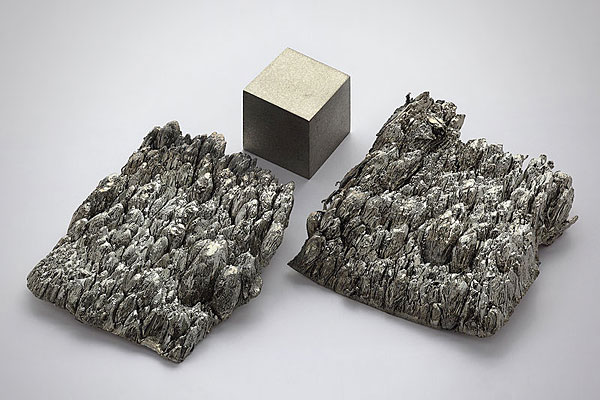A NOTE ON RARE EARTH ELEMENTS
INTRODUCTION

Rare earth elements or rare earth metals are a group of seventeen elements in the Periodic Table including Scandium, Yttrium and 15 Lanthanoids with Z ranging continuously from 57 to 71 ( La – Lanthanum, Ce-Cerium, Pr- Praseodymium, Nd-Neodymium, Pm- Prometheum, Sm-Samarium, Eu – Europium, Gd – Gadolinium, Tb-Terbium, Dy-Dysprosium, Ho-Homium, Er- Erbium, Tm- Thulium, Yb-Ytterbium and Lu- Lutetium) . Scandium and yttrium are considered rare earths since they tend to occur in the same ore deposits as the lanthanoids and exhibit similar chemical properties.
The term “rare earth” arises from the minerals from which they were first isolated, which were uncommon oxide-type minerals (earths) found in Gadolinite extracted from one mine in the village of Ytterby, Sweden. However, with the exception of the highly-unstable prometheum, rare earth elements are found in relatively high concentrations in the earth’s crust with cerium being the 25th most abundant element in the earth’s crust at 68 parts per million.
USE IN INDUSTRY

Rare earth elements are used in many modern technological devices, including superconductors, samarium-cobalt and neodymium-iron-boron high-flux rare-earth magnets, electronic polishers, refining catalysts and hybrid car components. Rare earth ions are used as the active ions in luminescent materials used in optioelectronics applications, most notably the Nd-YAG laser. Erbium-doped fibre amplifiers are significant devices in optical-fibre communication systems. Phosphorus with rare earth dopants are also widely used in cathode ray tube technology such as television sets. The earliest color television CRTs had a poor-quality red; europium as a phosphor dopant made good red phosphors possible. Yttrium iron garnet (YIG) spheres have been useful as tunable microwave resonators. Rare earth oxides are mixed with Tungsten to improve its high temperature properties for welding, replacing thorium which was mildly hazardous to work with. Many of these are essential ingredients in mobile phones, video game machines, computers and even green technologies. Tiny amounts of rare earths dysprosium or terbium might soon be used in electric cars as these let batteries work at high temperatures.

WORLD PRODUCTION SCENARIO
Rare earth elements are used in many modern technological devices, including superconductors, samarium-cobalt and neodymium-iron-boron high-flux rare-earth magnets, electronic polishers, refining catalysts and hybrid car components. Rare earth ions are used as the active ions in luminescent materials used in optioelectronics applications, most notably the Nd-YAG laser. Erbium-doped fibre amplifiers are significant devices in optical-fibre communication systems. Phosphorus with rare earth dopants are also widely used in cathode ray tube technology such as television sets. The earliest color television CRTs had a poor-quality red; europium as a phosphor dopant made good red phosphors possible. Yttrium iron garnet (YIG) spheres have been useful as tunable microwave resonators. Rare earth oxides are mixed with Tungsten to improve its high temperature properties for welding, replacing thorium which was mildly hazardous to work with. Many of these are essential ingredients in mobile phones, video game machines, computers and even green technologies. Tiny amounts of rare earths dysprosium or terbium might soon be used in electric cars as these let batteries work at high temperatures.
A few sites are under development outside of China, the most significant of which are the Nolans Project in Central Australia, the remote Hoidas lake project in northern Canada and the Mt. Weld project in Australia. The Hoidas Lake project has the potential to supply about 10% of the $1 billion of REE consumption that occurs in North America every year.
PROCESSING TO OBTAIN RARE EARTHS

Due to the phenomenon known as lanthanide contraction, yttrium, which is trivalent, is of similar ionic size todysprosium and its lanthanide neighbors. Due to the relatively gradual decrease in ionic size with increasing atomic number, the rare earth elements have always been difficult to separate. Even with eons of geological time, geochemical separation of the lanthanides has only rarely progressed much farther than a broad separation between light versus heavy lanthanides, otherwise known as the cerium and yttrium earths. Rare earth minerals, as found, usually are dominated by one group or the other, depending upon which size-range best fits the structural lattice. Thus, among the anhydrous rare earth phosphates, it is the tetragonal mineral xenotime that incorporates yttrium and the yttrium earths, whereas the monoclinic monazite phase incorporates cerium and the cerium earths preferentially. The smaller size of the yttrium group allows it a greater solid solubility in the rock-forming minerals that comprise the earth’s mantle, and thus yttrium and the yttrium earths show less enrichment in the earth’s crust, relative to chondritic abundance, than does cerium and the cerium earths. This has economic consequences: large ore bodies of the cerium earths are known around the world, and are being actively exploited. Corresponding ore bodies for yttrium tend to be rarer, smaller, and less concentrated. Most of the current supply of yttrium originates in the “ion adsorption clay” ores of Southern China. Some versions of these provide concentrates containing about 65% yttrium oxide, with the heavy lanthanides being present in ratios reflecting the Oddo-Harkins rule: even-numbered heavy lanthanides at abundances of about 5% each, and odd-numbered lanthanides at abundances of about 1% each. Similar compositions are found in xenotime or gadolinite.

